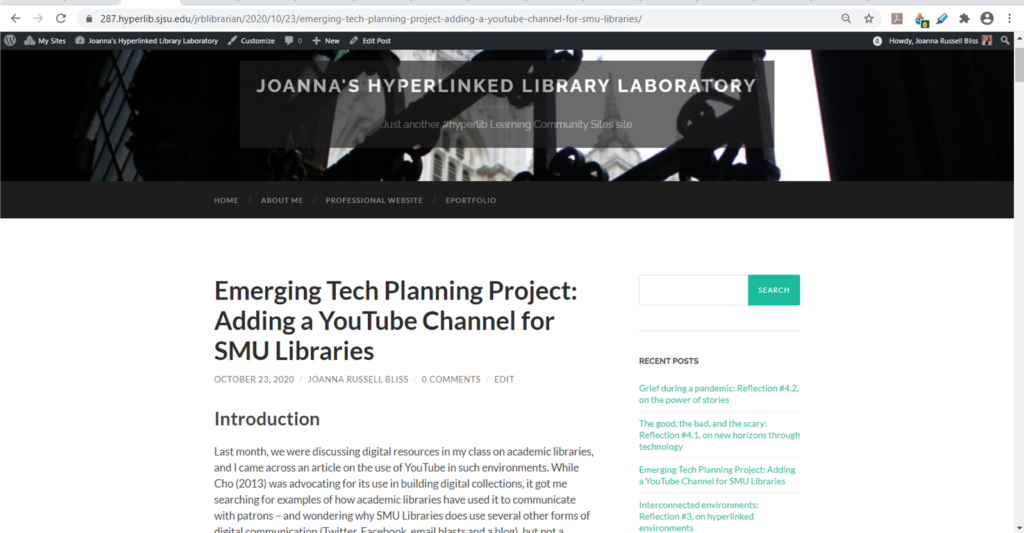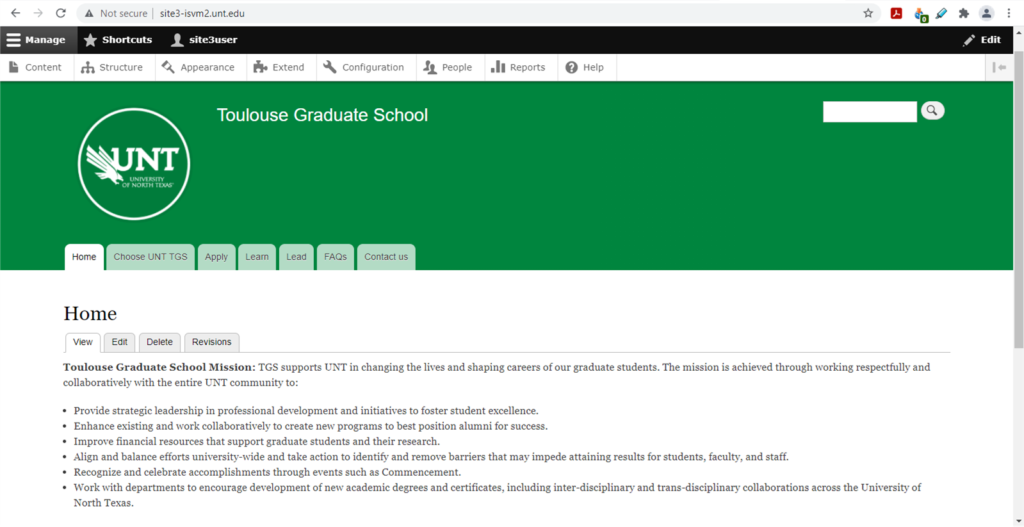INFO 5745, Reorganization of the UNT Toulouse Graduate School Website
The purpose of this assignment, done with a partner, was go through the steps necessary to revamp a website: Plan a timeline; research the context, content and users of and the website; analyze data collected and determine new labels for the site; map existing content and determine a new blueprint and wireframe for the site and pages; create a mock-up of the new site architecture on Drupal; and summarize all of the above in a packet for a client. The packet was turned in on August 4, 2021, along with spreadsheets of a Gantt chart, a content inventory of the existing site, and a sheet detailing the suggested reorganization; all four documents can be downloaded below.
Created over five crazy weeks, my partner and I worked through the above steps to evaluate and redesign a portion of the UNT website, that of the Toulouse Graduate School. Our first challenge was to understand the existing site and its users. I researched the organization and the stakeholders for the website, then created a user experience survey used to gather information about prospective students for the graduate school and what they would hope to learn on the site. This data allowed me to create personas that could be used later on to confirm the redesign met user needs.
The next portion of our work focused on mapping existing content and agreeing on new labels and organization of the site. After I did a complete content map of the existing site, my partner considered page layout through wireframes while I suggested a new blueprint for the site, and he also created a new controlled vocabulary for the site. Finally, we took all of this information and used it to create a mock-up in Drupal. While the page layout options were limited, it allowed us to demonstrate how to find the upper-most pages in a new organization. I continued my previous work, creating the pages and architecture in Drupal, then my partner came in and did what he could with the page layout, particularly in redesigning the site footer.
This assignment applied to several ALA competences, but within the technical competences, it most closely correlates to 4C, assessing and evaluating technology-based services, and 4D, analyzing emerging technologies in order to implement relevant technological improvements.
INFO 5960, Director’s Brief
The purpose of this assignment was to develop a director’s brief about an emerging technology in libraries; the below brief investigates movement labs on two different campuses here in the U.S. The brief was originally turned in via our course website on November 22, 2020; the brief can be downloaded here.
This brief gave me a chance to research something near and dear to my heart: Investing in technology that enables experimentation for performance and movement. These labs give students, faculty and staff the ability to explore the possibilities of using expensive equipment to record and manipulate movement, to use projections in performances, to visualize choreography using virtual reality goggles, and more.
The brief covers the origins of these labs at The Ohio State University, and the common technology found at such labs, as well as how to learn more about these labs and considerations for implementation. It also gave us the chance to experiment with a more graphic presentation of the information, which allowed me to play with various templates at Canva to create the brief.
This project correlates to the last two core competences for technical knowledge and skills, assessing and evaluating the use of emerging technology (4C), as well as the practical considerations for implementing the technology (4D).
INFO 5960, Emerging Tech Planning Project
The purpose of this assignment was to create a plan for incorporating an emerging technology into any library; the below plan is based on my experience at SMU as a Research & User Experience Intern. The post below was originally turned in on our course website on October 23, 2020. Because the course site is erased at the end of every term, I have replicated my personal posts and assignments on this website; the full assignment can be read via the blog.

The assignment gave us a template to use for planning such a large-scale project, but, of course, we had to fill in all of the details on our own. The central idea of the project can be summed up into an Action Brief Statement; the ABS from my project was as follows:
Convince library staff and administrators that by adding a YouTube account to our digital presence (and embedding it on our library website) they will enhance user knowledge of how to use our website, which will improve user experience because patrons will be able to access more resources and expand their research without having to ask librarians for assistance.
Once we’d considered audience, project goals, and the ABS, we had to expand our thoughts into such practical areas as guidelines and policy, funding and staffing, and training and promotion, as well as the continuous evaluation necessary to determine whether the project is succeeding, as well as how it could be improved.
This project correlates to several of the ALA’s core competences for technical knowledge and skills. Obviously it considers possible information and communication technologies for service delivery (4A). It also assesses and evaluates the use of such technology (4C), as well as the practical ways of implementing the technology (4D).
INFO 5740, Digital Library Review
The purpose of this assignment was to evaluate an existing digital library. The below PowerPoint presentation containing my evaluation of Digital Maryland was turned in on June 20, 2020.
This review enabled us to dig deeply into a particular digital library, seeing how the project was developed and to analyze whether or not the project is successful. We evaluated whether the mission statement was being carried out, who has responsibility for the project — both the managing organization and its partners, and how it is funded. We looked critically at the resources, collections and exhibits: Do the resources relate back to the mission of the project? Is the metadata sufficient for searching — or for research? How do the exhibits connect the resources? And we investigated its services and technology: How does the library interact with its audience? How well does the interface work for users?
I found that the library had a decent foundation, but that there is plenty of room for improvement. Compared to libraries with similar missions, like the Portal to Texas History housed at UNT, the library at Digital Maryland had just a fraction of their resources, and was lacking in services, particularly interactivity. I suspect that a lack of manpower and budget is to blame. As I assert in one of the final evaluation slides, “Trying to create such connections and exhibits takes a great deal of time, particularly when you do so with multiple partner organizations. The fact that the most recent exhibit was created in 2005 is also a sign that the current managers of the site just don’t have the time or resources to create any more of them.”
This review correlates to all four of the ALA’s core competences for technical knowledge and skills, particularly 4C, the assessment and evaluation of technical products and services, and 4D, understanding the principles and techniques for identifying and analyzing emerging technologies and innovations.
